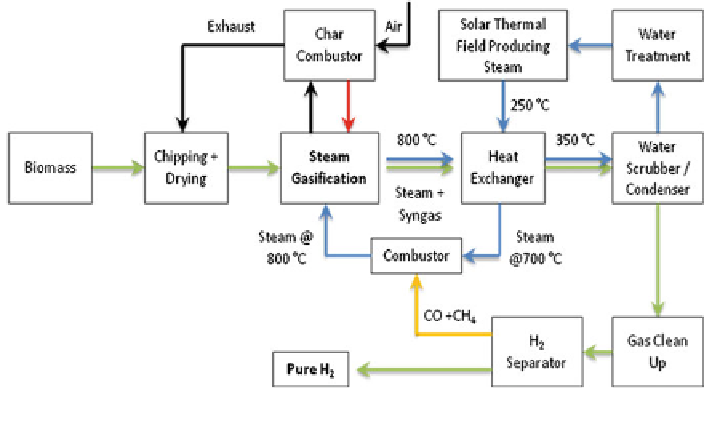Environmental Engineering Reference
In-Depth Information
Fig. 2 Sustainable hydrogen-enriched syngas/hydrogen production process
scrubber/condenser that eliminates any tars and condenses out the
—
the steam. The condensed water is processed before being reheated in a solar thermal
fl
fluidizing agent
field and the heat exchanger. The heated steam is brought up to its
final temperature
in a combustor before being once again injected into the gasi
er. Back at the water
scrubber, the cooled product (synthesis) gas is cleaned some more before the H
2
is
separated out. All other combustibles are reused in the facility to superheat steam or
heat the gasi
cation reactor.
2 Experimental Facility and Procedures
A 100 kW-capacity dual
fl
fluidized bed thermal steam gasi
er is proposed at FSU.
As the
first step, a single reactor bed was built to test many of the sub-systems of the
facility and determine the thermal ef
ciency of the chemical process. A schematic
of the single bed system is shown in Fig.
3
. In the absence of the char combustor,
heat is externally supplied to the reactor using series of electric heaters controlled
with variable transformers. To precisely control the amount of steam used in the
reactor, a standard electric boiler/superheater unit was installed. The advantage to
both these changes is it gives the operator a highly controlled and measured pro-
cess. The hot synthesis gas is then sent through a cyclone
filter to remove any solid
particles, followed by a heat exchanger, where the gas is cooled to about 400
°
C.
The gas is then passed through a venturi water scrubber/condenser and
filters to
further improve the gas quality. The resulting gas chemical characteristics are
monitored in situ using a gas chromatograph before it is burned in a controlled
Bunsen burner
flame. The complete thermal characteristics of the system, as shown
in Fig.
4
, will be monitored and controlled.
fl

Search WWH ::

Custom Search